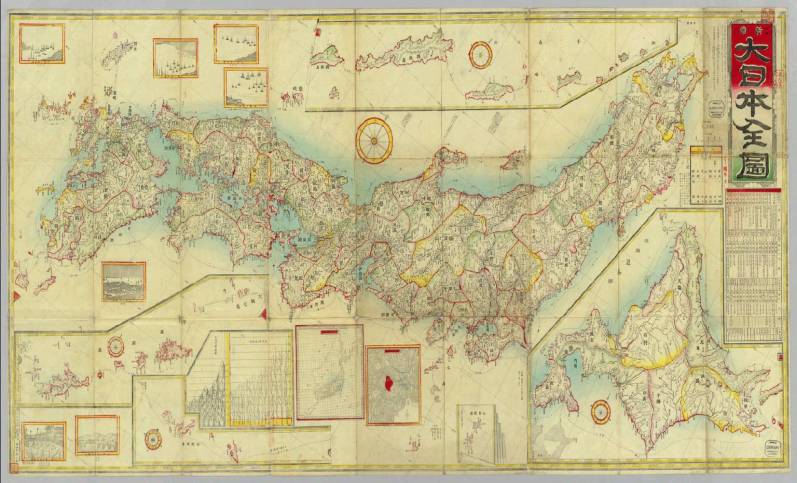
1835 Map by Matsumoto Yasuoki.

1872 Map by Uchida Shinai showing same characters.
Historical maps show the perception of territory people had in a period of time in history. One of the earliest Japanese records on Ulleungdo and Dokdo is a document entitled, Onshu shicho goki,which was edited by Saito Hosen in the year 1667. This document has a well-known passage that states:
"Oki is in the middle of the North Sea, so it is called Okinoshima. Going further from there for two days and one night in the direction of northwest one reaches Matsushima. Also there is Takeshima at another day´s travel distance. These two islands are uninhabited and getting a sight from Koryo (Korea) from there is like viewing Oki (Island) from Onshu. Thus Oki island is the northwest boundary of Japan."
This quote is very important, maps of that era and even 150 years thereafter had part of it written next to the islands . The passage was often written in such a manner spanning both islands linking them as a pair. This supports the belief that Ulleungdo and Dokdo were often viewed as "sister islands." The Chinese characters 抶邴淜諲磩騅寪錈騅 translated means "viewing Koryo (Korea) from here is the same as viewing Shimane (Japan) from Oki Island." These characters can be seen on the following maps.
(David Rumsey Collection)
 1835 Map by Matsumoto Yasuoki. |
 1872 Map by Uchida Shinai showing same characters. |
 The script, "抶邴淜諲磩騅寪錈騅" again spans Ulleungdo and her "sister island" in this map. |
 Yet again we see the text "viewing Koryo from here is the same as viewing Shimane from Oki Island." |
The phrase not only suggests that Ulleungdo-Dokdo were inseparable, it also shows that Korea was perceived to have had a stronger bond to these islands than did Japan by using the comparative analogy of Ulleungdo-Dokdo/Korea and Oki Island/Shimane Japan.
During the late 19th century the maps began to change somewhat. The positions of the Ulleungdo and Dokdo drifted in a westward direction. This could be partly attributed to the influence of the inaccurate maps made by Western cartographers. As a general rule, Ulleungdo is positioned at around 130 degress and Dokdo around 131 degrees; also Ulleungdo and Dokdo are never far apart from each other on these maps. However, if Dokdo had always been Japan´s inherit possession as the Japanese Foreign Ministry so states, then European maps should have followed the names and location the Japanese gave to Dokdo, and not vice-versa. These errors will be dealt with later. Japanese documents from around the mid-1870s seem to show the Meiji Government of Japan had little or no interest in both Ulleungdo and Dokdo. Not surprisingly, a large percentage of Japanese maps of this era fail to show Ulleungdo or Dokdo islands at all. Often cartographers opted to insert appended maps of other islands or simply filled this space with ornate drawings for visual appeal. A common practice was to curl up a corner of an appended map and insert the islands below. This would again suggest both islands were of no great importance and their inclusion on the map was almost an afterthought. In other words, as Japan´s perception of Dokdo changed, so did her maps.
















In conclusion, Japanese maps both very old and more recent combined with historical documents show us a number of things: First, the Japanese of the mid 19th century showed a lack territorial perception with regard to the positioning and possession of Dokdo. This should not be misconstrued as omission. Japanese cartographers did to some extent follow the lead of Western mapmakers, but the Japanese were not under the spell of Siebold's error, nor did the Japanese suddenly forget the existence of Takeshima and invent a new fictitious island. It seems the Japanese understood that Dokdo and Ulleungdo were not Japanese territory.